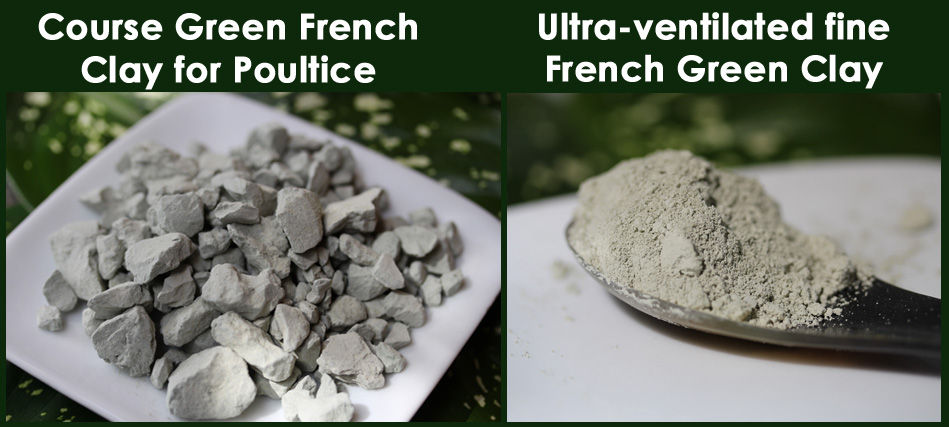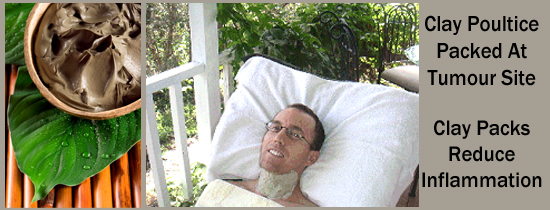French Green Clay
Clay is useful in alleviating pain, dealing with toxicity, managing flare-ups and healing crises and dealing with gastrointestinal problems. It is a very effective first line treatment for patients doing the Gerson Therapy.
French green clay has been used since Roman times both internally and externally.
Quality and Colors
The clay must be virgin and untreated. Green is the most active and the least tolerated in the hypersensitive person. The more it is exposed to sun, air and rainwater, the more active it becomes. Expose the clay to sun just prior to use. The clay will keep indefinitely in darkness.
French Green Clay is often named because of its properties and may be extracted from quarries other than French. At Hawaii Naturopathic Retreat Center we only use true French Green Clay, which is extracted in Southern France according to a specific protocol involving sun drying. French Green Clay contains many valuable elements including Montmorillonite, mineral oxides, magnesium, calcium, potassium, dolomite, silica, manganese, phosphorous, silicon, copper, and selenium. French Green Clay also contains iron oxides and decomposed plant matter, which gives clay its green color.

Internal Uses of Healing Clays
The clay we use internally is very fine. We soak one tsp of powdered clay in a glass of water over night and drink the water in the morning. The solution may have a constipating side effect. Drinking the clay solution is however very effective for the following purposes:
- Detoxification of the digestive system (the absorptive action of clay pulls contaminants from the body)
- Bacterial, organic and non-organic toxicity
- Elimination of internal parasites (digestive tracts)
- Immune System Support (clay used internally stimulates the body’s elimination system and supports organ function)
- Fixes free oxygen in the blood stream (occurs once the liver has been restored to full function )
- Increases T-cell count
- Fights free radicals
- Mercury poisoning!
- Trace mineral supplement
- Liver Detoxification
- Stomach Aches and bacterial food poisoning
- Alkalizing agent in the body
External Uses of Healing Clay
Clay used externally may be coarse. It is first soaked in water to form a paste easy to spread on the area to treat. Topical treatments include Packs , Compresses and Masks. Clay packs are used to alleviate headaches, hot inflammatory pain, joint pain, arthritis, reduce tumor inflammation and areas of fluid retention caused by trauma, infection or generalized edema. They absorb toxins, alleviate congestion and spasm in the deep organs of the liver, gallbladder, and kidney, as well as muscle spasm. They are useful in bone rebuilding, for stomach pains and diarrhea. There is a protective effect against gastroenteritis, cholera, dysentery, general food poisoning and ‘sour’ stomach. Clay can also be put in a bath in the use of heavy metal detoxification.

Clay Packs
Earth Cures: A Handbook of Natural Medicine for Today by Raymond Dextreit
Bone and Muscle Damage due to Traumatic Injury
Clay pack applied immediately after injury, applied 1/2 – 1 inch thick and covered, changed as needed ( 1/2 – 12 hrs. ), duration to maximum tolerance.
Carpal Tunnel Sydrome and Tendonitis
Clay wrap around entire area if possible, 1/4 – 1/2 inch thick, covered, for 20 minutes to an hour initially, increased to overnight applications as tolerance permits, for three days to three weeks.
Treatment of Internal Organs
Clay compress (dressing saturated with hydrated clay ) applied to cover the organ for 20 minutes per application to start, tolerance carefully monitored, extended to 1 hour applications as tolerable, progress to clay pack and 20 minute treatments, then to one hour as tolerance permits– as needed with internal cleansing support.
Chronic Headaches
Clay pack applied to the nape of the neck for twenty minutes, then applied to the forehead for twenty minutes ( continue to alternate as needed )
Skin Conditions (acne, eczema, rashes, more… )
Depending on the condition, clay compresses or packs can be used ( any cystic condition requires dense packs applied for an extended amount of time).
Rapid healing of injuries ( bruises, sprains, burns, etc.)
Thick clay packs applied to sprains, bruises, breaks, ect. Thin clay strips, covered, or compresses applied to burns. For any injury that includes a break in the skin, never allow the clay to dry. Simply change out the dressing as needed.
Severe Bacterial Infections
Wound cleaned thoroughly with liquid bentonite, clay packs applied at least 1/2 inch thick, dressings changed as often as required due to drainage, never allow clay to dry on damaged tissues.
Skin rejuvenation and deep cleansing
One to twelve cups of bentonite added to a hot bath; hydrated bentonite used as a normal soap; clay masks applied to the skin; clay formulations used in a massage treatment.
Radiation
Clay must be used internally and immediately. Clay baths repeated to tolerance with as much hydrated clay as the individual can tolerate ( based on their stamina ) for 20 minutes to one hour. Compresses or thick clay wraps, alternating treatment to key locations of the body (targeting the lymphatic system and primary organs, treatments based on tolerance).
Eye strain
Thick clay packs applied to both closed eyes, covered and left on from between 20 to 90 minutes.
Cancer / Tumors / Skin Cancer
Clay packs applied directly to the affected area, first for 20minutes, and then repeated to tolerance.
Moroccan Rhassoul (Ghassoul) Clay
Rhassoul Clay is a remarkable natural mineral clay that originates from the Atlas Mountains of Morocco. It is naturally found and mined from ancient deposits within the Atlas Mountains. It has been mined since the eight century.
Moroccan Rhassoul Clay can be used as a soap, shampoo, skin conditioner and facial and body mask. Rhassoul Clay is much superior to other clays for skin and hair treatment because it contains higher percentages of silica and magnesium along with potassium and calcium.
Other common names for Rhassoul Clay are: Red Clay, Red Moroccon Clay, Ghassoul Clay, Oxide Clay.
The Mineral Composition of Rhassoul Clay
- Silica- 58%
- Aluminum- 2.47%
- Iron- 0.64%
- Sodium- 2.3%
- Magnesium- 25.2%
- Calcium- 2.34%
- Moisture- <8%

Bentonite Clay
Bentonite Clay is sedimentary clay composed of weathered and aged volcanic ash. It consists mostly of montmorillonite. Montmorillonite is a very soft group of minerals consisting mostly of silicon and oxygen. They form in microscopic crystals forming a clay.
Bentonite Clay derives its name from Fort Benton in Wyoming where the clay was first identified. It is also known as Montmorillonite, Sodium Bentonite or Wyoming Bentonite.
In therapeutic use Bentonite Clay is extremely versatile and a very effective and powerful healing clay. It can be used externally as a clay poultice, mud pack or in the bath and in skin care recipes. Bentonite clay alleviates rashes, eczema and psoriasis.
Or, it can be used internally by drinking liquid bentonite clay. When taken internally liquid bentonite helps the intestinal system to eliminate toxins. Liquid bentonite passes though the body undigested. It is taken internally for when it is mixed with water it becomes extremely porous and has the ability to attract by electrical charge heavy metals, toxins, harmful bacteria, pesticides and other pathogens. The clay binds with these different toxins and then makes an exit via the colon and the kidneys. Bentonite clay is also effective at protecting our bodies from radiation.
Peruvian Macaws seem to know instinctively the powerful detoxification effects of bentonite clay. During some parts of the year only poisonous fruits are available to eat to them and the birds will visit a clay lick first in the morning and eat some clay which absorbs the alkaloid toxins found in the poisonous fruit they eat during the day.
The Mineral Composition of Bentonite Clay
- Silica- 61.4%
- Aluminum- 18.1%
- Iron- 3.5%
- Sodium- 2.3%
- Magnesium- 1.7%
- Calcium- 0.04%
- Titanium- 0.02%
- Potassium- 0.01%
- Moisture- 7.8%
- pH – 8.3 – 9.1

